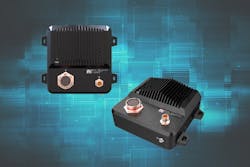Embedded Hardware’s Role in a Trusted AI Ecosystem
What you’ll learn:
- How embedded AI hardware reliability is handled in the defense and aerospace fields.
- How that reliability is assured and tested.
With artificial intelligence progressing into areas as diverse as self-driving vehicles and military drones, as well as robots and satellites, it may feel like AI touches everything, everywhere. This has made trust a critical requirement within the embedded electronics ecosystem.
By any definition, trust incorporates the concepts of consistency, reliability, and predictability to build confidence among the parties involved. And for AI systems deployed in military situations or safety-critical environments, that definition expands to include secure and explainable interactions.
In fact, embedded hardware plays a foundational role in fulfilling this broader definition, serving as the backbone upon which trusted AI systems are built.
How Hardware Impacts Trust
While much focus around AI trust centers on software and algorithms, the hardware layer is where a unique set of risks also reside, in addition to those software-based security protocols that are beginning to be commonplace. From secure boot as well as encrypted memory and storage to real-time performance monitoring, embedded hardware enables the development of AI systems that promote a trusted ecosystem.
>>Check out more content on AI and its trustworthiness in a product's lifecycle
Recognizing embedded hardware as part of the trust infrastructure means viewing it as one of the layers in a holistic security architecture. The hardware ensures that AI systems are resilient against both cyber and physical threats, can continue to operate reliably under real-world conditions, and safeguard the confidentiality and integrity of the data being ingested, processed, and communicated.
As autonomous platforms are deployed into more critical and contested environments, and as accomplishing AI-at-the-edge gains ground, the trustworthiness of the decisions made will increasingly rely on the system’s ruggedness, and how well the hardware is designed to support AI with integrity, security, and resilience (Fig. 1).
Real-Time Monitoring and Built-in Safety Mechanisms
Embedded hardware contributes directly to operational safety through features like watchdog timers that can detect and recover system failures or malfunctions, as well as lock-step processing and redundant cores, where multiple processors performing the same operation can cross-check each other for accuracy. These mechanisms detect hardware or software faults during AI execution and enable failover or safe shutdown routines to respond to anomalous behavior.
Tamper Resistance and Physical Security
Autonomous systems often operate in uncontrolled or adversarial environments. Embedded hardware that includes tamper detection, secure key storage (e.g., TPMs or HSMs), and side-channel attack protections offers a level of physical security that adds trust to an AI-based embedded system. By preventing unauthorized access to sensitive AI models or mission data, especially for mission-critical applications, hardware-enforced security provides confidence in data integrity.
Reduced Data Latency and Deterministic Support
Embedded platforms enable AI-driven decisions that can process data at the edge, reducing the reliance on cloud connectivity. But localized processing isn’t only about computation speed and data transmission. It reinforces system reliability by providing an enhanced level of mission continuity. This helps the mission maintain functionality in denied or disconnected environments, especially for autonomous systems.
Autonomous systems must make decisions in real-time, often under strict latency constraints. Embedded AI platforms must guarantee deterministic behavior to confidently provide safety-critical operations, like obstacle avoidance or threat response. With rugged and reliable hardware driving the data processing engine, users and stakeholders can be assured that the decisions made by the AI platform are being fueled by up-to-date data inputs (Fig. 2).
Ruggedization and Survivability
Components used in AI-at-the-edge systems need to be ruggedized to withstand challenging environmental factors and ensure the survivability of the system. Without the right ruggedization approach, right from the beginning, these hardware components can fail. Typical environmental stresses that embedded hardware will endure include:
- Extreme temperature fluctuations
- High, prolonged levels of shock and vibration
- Extended lifecycles
For autonomous applications, survivability takes on a whole new dimension. Systems are expected to operate for extended periods without any human intervention, real-time upgrades, or maintenance. The use of rugged electronics reduces mission risk, while increasing connectivity provides a more reliable data-delivery infrastructure and ensures stable AI-based processing and computing at the edge.
In fact, because of its contribution to the trust ecosystem, rugged hardware has helped pave the way for a whole new economy of commercial spaceflight. It’s also enabled military entities to reimagine the use of electronics in the defense landscape through the implementation of AI-based networking. Without reliable hardware components, AI processing simply wouldn’t be possible.
Secure, Rugged Hardware for AI-Based Systems
By processing data on secure, ruggedized systems and reducing reliance on cloud connectivity, edge-based AI processing enhances situational awareness, automates threat detection, and ensures rapid, autonomous decision-making in mission-critical environments. This level of intelligence requires a trusted architecture to ensure the data used to assess actions and outcomes is up-to-date, reliable, and secure. And the fact is, with increased reliance on ruggedized hardware, affordability becomes a natural side benefit.
Integrating more information inputs at the edge means remote systems need high-performance, low-power processing to manage this data. Along these lines, Aitech’s A230 (for military and defense operations) and the S-A2300 (for low Earth orbit space environments), designed with NVIDIA’s advanced Orin architecture at the core, are examples of systems that are both rugged and reliable, providing a dependable processing infrastructure (Fig. 3).
These AI supercomputers pre-process data locally, right where it’s needed, lowering latency in data transmission through edge computation. These edge-based systems also reduce the amount of sensitive data that’s vulnerable to cyberattacks. The robust, durable units withstand extreme environments, ensuring uptime and system processing, even when subjected to harsh and rugged conditions.
Whether in the battlespace, onboard next-generation aircraft, or in the harsh conditions of space, rugged AI-ready hardware provides the speed and reliability that edge AI systems need to stay ahead of evolving security challenges.
A Holistic Approach to Trust
As AI systems become more deeply embedded in critical infrastructure, trust will continue to be a top priority. Yet, the effectiveness of AI hinges not only on the sophistication of algorithms, but also on the trustworthiness of the system it runs on. Especially where safety and mission assurance are paramount—including military, defense, and space-rated applications—the system hardware must do more than compute. It must survive, protect, validate, and respond to operations.
A trusted AI ecosystem in embedded computing is one where hardware actively enforces security, enables consistent real-time performance, detects anomalies, and safeguards sensitive data. At the heart of this trust lies the embedded hardware, which plays a critical role in ensuring that AI decisions are secure, reliable, and verifiable.
>>Check out more content on AI and its trustworthiness in a product's lifecycle
About the Author
Dale Segler
Director, US Business Development - Mil-Aero, Aitech
Dale Segler is Director of U.S. Business Development - Mil-Aero at Aitech.




